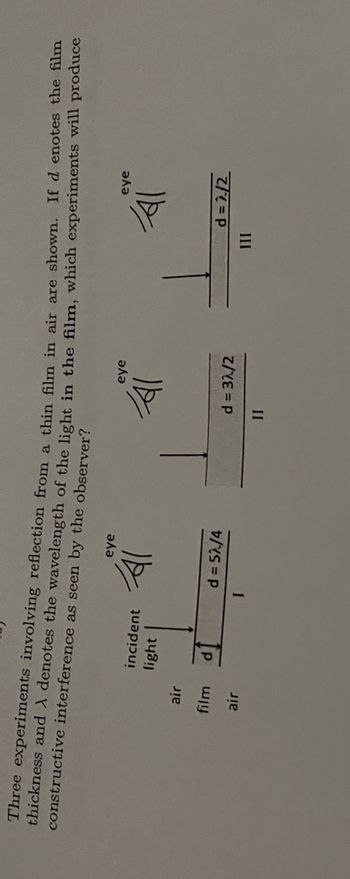Question

Transcribed Image Text:**Title: Understanding Thin Film Interference**
**Introduction:**
Thin film interference is a fascinating optical phenomenon observed in everyday life, such as in the colorful patterns seen on soap bubbles. It occurs due to the interaction of light waves reflected from the upper and lower boundaries of a thin film.
**Text Description:**
Three experiments involving reflection from a thin film in air are shown. If \( d \) denotes the film thickness and \( \lambda \) denotes the wavelength of the light in the film, which experiments will produce constructive interference as seen by the observer?
**Experiment Details:**
- **Experiment I:**
- **Diagram:** The observer's eye looks at the film with thickness \( d = 5\lambda/4 \).
- *Explanation:* The film is sandwiched between air layers, and incident light reflects off the top surface and bottom surface within the film.
- **Experiment II:**
- **Diagram:** The observer's eye looks at the film with thickness \( d = 3\lambda/2 \).
- *Explanation:* Similar to Experiment I, incident light undergoes reflection at both film surfaces.
- **Experiment III:**
- **Diagram:** The observer's eye looks at the film with thickness \( d = \lambda/2 \).
- *Explanation:* Incident light reflects off the film's surfaces, leading to potential constructive or destructive interference.
**Graph/Diagram Explanation:**
Each of the experiments includes a horizontal line representing the thin film with markings indicating where the light reflects. The top and bottom lines indicate the boundaries of the film with thickness \( d \) noted next to them.
**Conclusion:**
To determine which experiment will produce constructive interference, examine the path difference and phase shifts encountered by the light waves when reflecting within the film. Constructive interference occurs when the path difference is an integer multiple of the wavelength. Analyze the specific conditions based on film thickness \( d \) and wavelength \( \lambda \) to predict visibility of bright bands in these experiments.
Understanding these principles helps explain the colorful displays seen in various thin film contexts, an important concept in optics and wave phenomena.
Expert Solution
This question has been solved!
Explore an expertly crafted, step-by-step solution for a thorough understanding of key concepts.
Step by stepSolved in 3 steps with 2 images

Knowledge Booster
Similar questions
- A diffraction grating gas 2270 lines per centimeter. At what angle in degrees will the first order maximum be for 560nm wavelength green light?arrow_forwardA thin layer of oil n =1.2 is on top of a substance with index of refraction n = 1.5. Normally incident 551nm light in air is incident on the oil and is not reflected at all. Determine the minimum nonzero thickness of the film (in nm). Check correct show all workarrow_forwardMourning doves have a small batch of iridescent feathers. The color isproduced by a 260-nm-thick layer of keratin (n = 1.56), with air on both sides that are found around the edge of the feather barbules. For what visible wavelength (or wavelengths) would this structure produce constructive interference? A) 686nm, 412nmB) 406nmC) 686nm, 541nm, 412nmD) 541nmE) 1622nm, 811nm, 270nmarrow_forward
- Given a diffraction grating of red light at 650nm at an angle of 37.5o how many lines per cm does the grating have?arrow_forwardA thin film of oil is on water. What is the thinnest that the oil can be to have constructive interference on reflection? The wavelength of the light in air is 480nm. Assume the beam starts in air. [n =1.00 ,n =1.50 , nwaer =1.33]arrow_forward
arrow_back_ios
arrow_forward_ios